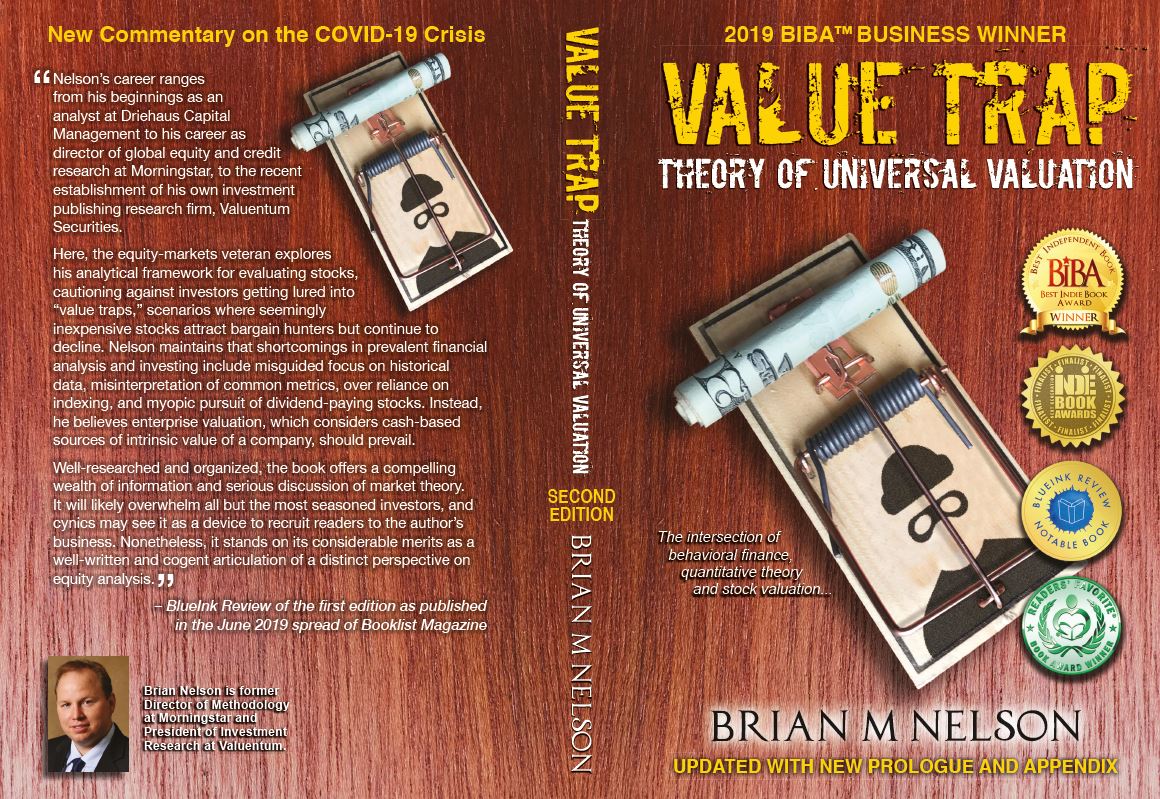Dividend Growth Selection in a Low Yield Environment
publication date: Sep 8, 2020
|
author/source: Brian Nelson, CFA
 Dear members:
Dear members:---
John Burr Williams' historical work The Theory of Investment Value, published in 1938, set the foundation for the widely known discounting mechanism inherent within equity valuation frameworks today. His text is often credited with the origins of the dividend discount model. Though Value Trap: Theory of Universal Valuation identifies enterprise valuation, or the discounted cash flow model (the free cash flow to the firm model, to be precise) as the causal driver of values and prices, the concepts are very similar. Stock values and prices are a function of future expectations.
---
Today, with highly accommodative Fed and Treasury policy, interest rates are ultra-low, and even yields on junk-rated debt have plummeted. For example, Ball Corp (BLL), a junk-rated credit (jargon for non-investment grade), just raised $1.3 billion through a 10-year bond that pays just 2.875%. I can think of a great many strong dividend paying companies that pay more than that yield today, ones with meaningful long-term dividend growth potential, too. Learn about the benefits of compound dividend growth here.
---
But how should investors position themselves with respect to identifying dividend growth equities in such a low interest-rate environment? You guessed it--by using forward-looking business model, cash-based intrinsic value and dividend growth/health analysis through the lens of enterprise valuation. In the calculation of an intrinsic value estimate of the company, for example, we forecast future expected free cash flows. We also have to pay very close attention to the balance sheet of the entity, as net cash is a source of equity value, while net debt is a detraction from equity value.
---
Through the course of the enterprise valuation process, we are able to develop unique insights on the forward-looking capacity of a dividend paying company to continue paying and growing its dividend. This assessment is reflected in the company's Dividend Cushion ratio (generally a ratio comfortably higher than 1 is really good). For example, Microsoft's (MSFT) Dividend Cushion ratio is 4.2x, meaning we think its annualized dividend rate has considerable room for growth--above and beyond what we're already forecasting. The enterprise valuation process also uncovers the capital-market dependency risk of the MLP and REIT business structures.
---
For example, we identified how most of the market was not capturing the all-important growth capital investment consideration within the valuation of MLPs in 2015. Participants were factoring in the growth in cash flows associated with investments, but they weren't considering that such growth comes with a cost to unitholders in the form of capital spending. This is partly why the sector faced imminent collapse years ago. The other part is that most were assessing the distributions of MLPs using cash flow measures that ignored key cash outflows. When energy resource prices collapsed in late 2015 and the credit markets dried up, these dynamics came home to roost for dividend investors.
---
The enterprise valuation process and its forward-looking cash-based components provide insights like this that go above and beyond traditional coverage metrics like the dividend payout ratio, while uncovering how certain metrics like distributable cash flow make little sense. Though we like a couple of the pipeline MLPs today, when they were trading at nosebleed levels in 2015, we couldn't get further away from them. Having risk-management insights implicitly embedded within the process of enterprise valuation helps us get a leg up on trends that could be very hazardous to a dividend growth portfolio.
---
So, where are we looking today for dividend growth? Perhaps this question is better answered by starting with what we don't like in dividend growth companies. First, we generally don't view banking or insurance entities as conducive to long-term dividend growth as they don't fit well within the enterprise valuation process given the arbitrary nature of their cash flows. The energy and chemical markets are also highly sensitive to input costs and energy resource pricing, so their business models aren't among the safest when it comes to paying a sustainable and growing dividend.
---
We also don't like companies that have very stretched balance sheets, namely a very large net debt position. For example, a company with a large net cash position (measured by summing cash and cash equivalents, including marketable securities, and subtracting short and long-term debt from that sum) is in a much better position to keep growing and raising its dividend than one that has a large net debt position, all else equal. One area that we pay close attention to is also hidden liabilities, as in the case of operating leases. Many restaurants and airlines may appear to not have much leverage, but the astute investor should always look at leverage on a lease-adjusted basis.
---
With all that out of the way, where do we like to look for some of the best dividend growth ideas for the future? For one, we need to assess management's willingness to pay. The S&P 500 Dividend Aristocrats index is a good place to start, but many of the companies on the list have tired business models and may not offer the type of dividend growth that investors are seeking to generate a hefty yield-on-cost and impressive compounding dynamic over many years. For example, two companies in the top 10 in that index are Exxon Mobil (XOM) and Chevron (CVX), and we'd be hesitant to add them to a dividend growth portfolio focused on the long run. Both Exxon and Chevron's Dividend Cushion ratios are below 1, too, indicating less-than-ideal coverage.
---
Management's willingness to pay is critical, so an understanding of how dividend growth has been the past few years is very important, but when we look for fantastic dividend growth ideas for the future, we also want to make sure that the management team has the capacity to keep raising the dividend--meaning there's so much more to dividend growth assessments than backward-looking analysis. For starters, we want our long-term dividend growth ideas to have strong competitively-advantaged business models, solid secular growth trends or recession-resistant characteristics, impressive balance sheets (sometimes and preferably with hefty net cash positions) and growing future expected free cash flows (strong Dividend Cushion ratios).
---
You can find many of these ideas in the Dividend Growth Newsletter portfolio. For example, Intel (INTC), Johnson & Johnson (JNJ), Cisco (CSCO), Microsoft (MSFT), Oracle (ORCL), and Apple (AAPL) have tremendous free cash flow generation capacity and very, very healthy balance sheets. We include the S&P Dividend ETF (SDY), iShares Int'l Select Dividend (IDV), and the dividend-heavy Health Care Select Sector SPDR (XLV) in the newsletter portfolio for broad-based thematic exposure, and we include Digital Realty Trust (DLR) and Realty Income (O) as our favorite REITs. We also like recession-resistant business models, including those from defense (Lockheed), mining (Newmont), and environment services (Republic Services)--industries that may do well irrespective of the economy. You'll notice we don't include any MLPs in the Dividend Growth Newsletter portfolio at this time.
---
Concluding Thoughts
---
Stock prices and values are based on future expectations, so not only does the enterprise valuation framework offer insights with respect to a company's intrinsic value (and its key cash-based components), but it also provides a solid framework to evaluate dividend coverage on a forward-looking basis. Specifically, the enterprise valuation process helps to inform the Dividend Cushion ratio, which is a forward-looking cash-flow based measure of a company's capacity to pay and grow its dividend into the future.
---
Management's willingness to increase the payout can be assessed by looking at a company's dividend track record, and generally, certain industries are more conducive to long-term dividend growth than others. For example, energy/chemical and banking entities are exposed to the vicissitudes of energy resource pricing, while banking entities could see their dividends get cut if the government should deem it appropriate. MLPs may not be great dividend growers in the long run.
---
On the other hand, entities that have solid competitively-advantage business models tied to secular or recession-resistant trends, that have strong balance sheets (preferably with net cash positions) and whose future expected free cash flows are robust and growing can often make some of the best candidates for selection within a dividend growth portfolio focused on the long haul. We hope you've found this article helpful.
------
Kind regards,
---
Brian Nelson, CFA
President, Investment Research
Valuentum Securities, Inc.
brian@valuentum.com
---

It's Here!
The Second Edition of Value Trap! Order today!

-----
---
Related: XLE, XES, XPO
---
Valuentum members have access to our 16-page stock reports, Valuentum Buying Index ratings, Dividend Cushion ratios, fair value estimates and ranges, dividend reports and more. Not a member? Subscribe today. The first 14 days are free.
---
Brian Nelson owns shares in SPY, SCHG, DIA and QQQ. Some of the other securities written about in this article may be included in Valuentum's simulated newsletter portfolios. Contact Valuentum for more information about its editorial policies.
0 Comments Posted Leave a comment